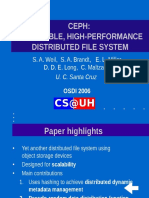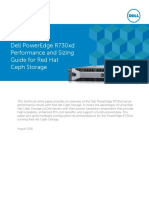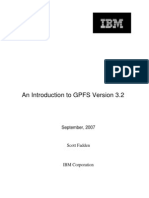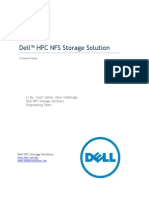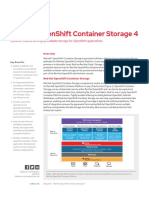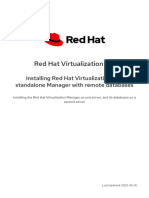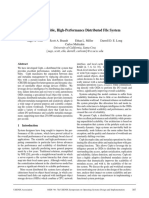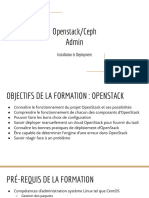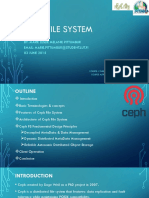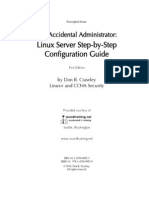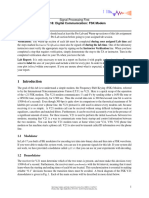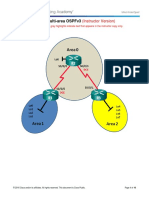CEPH FILE SYSTEM
BY: MARIE LESLIE MELANIE PITTUMBUR
EMAIL: MARIE.PITTUMBUR@STUDENT.LUT.FI
03 JUNE 2015
COURSE: COMPUTING CLUSTERS, GRIDS & CLOUDS
COURSE AUTHOR: PROFESSOR ANDREY Y. SHEVEL
ITMO UNIVERSITY, RUSSIA
�OUTLINE
Introduction
Basic Terminologies & concepts
Features of Ceph File System
Architecture of Ceph File System
Ceph FS Fundamental Design Principles
Decoupled MetaData & Data Management
Dynamic Distributed MetaData Management
Reliable Autonomic Distributed Object Storage
Client Operation
Conclusion
�INTRODUCTION
Ceph created by Sage Weil as a PhD project in 2007.
Ceph is a distributed file system that features: data replication and fault
tolerance while maintaining POSIX compatibility.
Foremost advantages: Excellent performance, Reliability, and Scalability for
Petabytes scale, dynamic and distributed systems.
It employs object-based storage & conventional hard disks are replaced with
intelligent object storage devices (OSDs).
Ceph has excellent I/O performance and scalable metadata management,
supporting more than 250,000 metadata operations per second.
�BASIC CONCEPTS & TERMINOLOGIES (1)
Components of a file: MetaData, Mechanism to access & store the file & Data
Filesystem finds out which blocks of disk space belongs to which file to append data
User
and create new files.
---File System = Abstraction--Data Blocks
MS-DOS FAT FS: Allocation tables to store the location of the next block storing the
data cluster of the file.
Unix Fast FS: Uses Inode blocks to store all file metadata & references to data
blocks
Block-based file systems: Files are segmented into evenly sized blocks of data.
Apart from block addresses, no context information about the file is provided
�BASIC CONCEPTS & TERMINOLOGIES (2)
Object-based file systems:
Data for each file is stored in a single object
MetaData is expandable and provides contextual about file
Global identifier: To locate object over a distributed system
Object File
System
Data
MetaData
MetaData servers perform metadata operations such as file open, file
rename
Low-level file I/O operations such as block allocation decisions for read &
write operations are delegated to intelligent OSDs.
Object based file systems are adapted to deal with data growth
Global
Identifier
�FEATURES OF CEPH FILE SYSTEM
Primary goals driving design of Ceph File system:
Scalability: Includes the overall storage capacity and throughput of the system
Performance: Access to files or directories by clients
Reliability: Self-healing and dynamic file system for no single point of failure
Ceph maximizes decoupling of metadata & data management by
eliminating allocation or inode lists. Data distribution algorithms used.
Ceph provides extremely efficient metadata management and
seamlessly adapts to various workloads for different computing
requirements.
By leveraging OSDs intelligence: Semi-autonomous, fault tolerant and
recovering file systems
�ARCHITECTURE OF CEPH FILE SYSTEM
Components of Ceph File System:
A client instance that exposes a POSIX file system
interface to a host
A cluster of OSDs storing both data and
metadata
A metadata cluster managing the namespace (file
names & directories), security, consistency &
coherence
Cluster monitors: Manage the cluster map of the
OSDs in case devices are added or removed.
�CEPH FS FUNDAMENTAL DESIGN PRINCIPLES (1)
Decoupled MetaData & Data Management
Management of the metadata & storage of the actual file data is separated
Long block lists (each of 512 bytes) are replaced with shorted object lists
Unlike other object-based file system, Ceph eliminates any allocation or inode
lists.
File data is striped onto predictably named objects -> Boosting performance
Uses random data distribution function, CRUSH to assign objects to storage
devices.
Through calculation any party can access the objects name and location ->
file contents
�CEPH FS FUNDAMENTAL DESIGN PRINCIPLES (2)
Dynamic Distributed Metadata Management
Metadata operations take up about half the workload of filesystems
Efficient management is critical to system performance
Ceph metadata cluster architecture: Dynamic sub-tree partitioning -> Single
authoritative MDS + Adaptive distribution of cached metadata across nodes
Current Access patterns to objects are used to distribute workload among
MDSs accordingly.
Effective use of OSDs resources.
Predict Scalability requirements in the future number of OSDs
�CEPH FS FUNDAMENTAL DESIGN PRINCIPLES (3)
Reliable Autonomic Distributed Object Storage
Petabyte scale systems are highly dynamic and nodes fail regularly.
Filesystem is implemented incrementally: new devices are added with time
while old devices are removed.
Data distribution has to be dynamic to adapt to availability of resources and
to maintain appropriate level of data replication.
Large volume of data constantly created, deleted or moved.
Ceph FS benefits from increase in reliability and availability of storage: OSDs
manage data migration, replication or recovery on their own.
�CEPH CLIENT
Client interface for Ceph file system incorporated into the Linux kernel (since 2.6.34)
Abstraction of the underlying metadata servers, monitors, and individual object
storage devices
Clients point of view: Only a mount point to the users filesystem which can be
accessed for normal I/O operations.
To run a ceph file system:
A running Ceph Storage cluster
A running Ceph metadata server
Mount the Ceph filesystem: Either as mounted device in /mnt/cephfs or using FUSE
or directory in users space using FUSE: /home/user/cephfs.
�CONCLUSION
A Comparison with other Large Scale Distributed Systems:
Large Scale systems
Parallel file & data
systems
Metadata & Data
decoupling systems
OceanStore & Farsite FS
Vesta, Galley & Swift
StorageTanks, GPFS
Offer Petabytes of reliable
storage space
High transfer rates by data
striping
Scalability limited by the use of
block-based disks &
Poor file access performance
due to use of allocation and
inode lists for file name lookup
Reliability & Scalability issues
due to lack of scalable
metadata access & robust data
distribution algorithms
Metadata & data distribution
functions not sophisticated
enough.
�REFERENCES
Sage A. Weil, Scott A. Brandt, Ethan L. Miller, Darrell D. E. Long, and Carlos
Maltzahn. 2006. Ceph: a scalable, high-performance distributed file system. In
Proceedings of the 7th symposium on Operating systems design and implementation
(OSDI '06). USENIX Association, Berkeley, CA, USA, 307-320.
http://www.ibm.com/developerworks/library/l-ceph/
http://ceph.com/docs/master/cephfs/
http://www.snia.org/sites/default/education/tutorials/2009/fall/file/CraigHarmer
_Object-based_File_Systems_An_Overview.pdf
